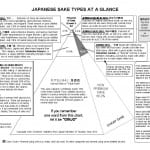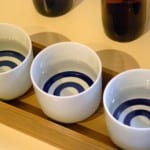Would that there be a tokubetsu junmai, Fodder?…
The late, great comedian George Carlin, in a skit called “I used to be Irish Catholic,” speaks of a time
when he and his friends would ask a priest named Father Russel weird questions during what they called “heavy mystery time.” One such deftly crafted conundrum concerned “Easter duty,” or receiving communion during the Easter season. George himself tells it with a thick New Jersey accent, rendering it much funnier than mere prose. Nevertheless:
“Hey, hey, hey Fodder! Hey, uh, suppose that you didn’t make your Easter duty and it’s Pentecost Sunday, the last day, and you’re on a ship at sea. And the chaplain goes into a coma! But you wanted to receive. And then it’s Monday, too late… But then you cross the International Date Line! Would that there then be a sin, Fodder?”
I remember this story each time I talk about the grades of sake called tokubetsu junmai and tokubetsu honjozo.
In short, tokubetsu means special, so tokubetsu junmai is special junmai, i.e. a bit better than regular junmai (but not quite as good as junmai ginjo), and tokubetsu honjozo is special honjozo, i.e. a bit better than regular honjozo (but not quite as good as ginjo). And, importantly, there are legally defined rules that determine what makes them special.
So, a junmaishu or honjozo can be tokubetsu, i.e. special, if it conforms to any one (or more) of three rules. One, it is made with 100% proper sake rice. Two, the rice used has been milled to ginjo levels, i.e. to 60% of its original size or better. And three, “something else special, approved as such, and listed on the label.”
The qualifying point will almost always be one of the first two above. Like, 99.9999 percent of the time, it will be. But the possibility exists that there is some bizzare-o reason a sake is qualified as tokubetsu. However, for all intents and purposes, we can forget about that third rule.
But when lecturing about these wonderful and under-appreciated two grades, there is invariably someone who wants to get to the very bottom of all this, and understand it with crystal clear clarity. Sake doesn’t roll that way, but nevertheless, they want to try to nail it down. So (s)he will come up with all kinds of weird concoctions and ideas, and will ask, “Would that then be enough to call it a tokubetsu?”
It might. It might not. It would be up to the folks in the National Tax Administration. But it is all but moot since almost without exception what qualifies a sake for tokubetsu will either be ginjo milling, the use of sake rice, or (commonly) both.
In fact, the only exception I recall ever having seen was a junmai-shu mixed with a slurry of daiginjo nigori-like dregs. Approval was received, the label explained it, and the sake sold as a tokubetsu junmai. But, really: whatevuh. It was an anomaly.
It needn’t be that difficult nor complex. Just bear in mind that, for all intents and purposes, tokubetsu junnmai and tokubetsu honjozo are legally defined grades that are special by virtue of having been made with 100% proper sake rice or by being made with rice (not necessarily proper sake rice) milled to ginjo levels, i.e. down to 60% of the original size or more. And often, it conforms to both of these rules.
 Why am I putting so much energy into this explanation? Because tokubetsu junmai and tokubetsu honjozo are some of my favorite sake. They are clearly a cut above the simple grades below them, but they do not conform (get sucked into?) the ginjo-flavor-and-aroma borg above them. Plenty of almost-rustic character, lots of interesting things happening in their flavor profiles, but still quite refined. While there are comparatively fewer products in these two grades, they are very much worth exploring and spending time with; eminently enjoyable.
Why am I putting so much energy into this explanation? Because tokubetsu junmai and tokubetsu honjozo are some of my favorite sake. They are clearly a cut above the simple grades below them, but they do not conform (get sucked into?) the ginjo-flavor-and-aroma borg above them. Plenty of almost-rustic character, lots of interesting things happening in their flavor profiles, but still quite refined. While there are comparatively fewer products in these two grades, they are very much worth exploring and spending time with; eminently enjoyable.
If these are that good, why then don’t the brewers that make them bump them up just a notch and sell them as ginjo and junmai ginjo? Surely most of them would qualify, and if not, could be tweaked to do so!
Indeed, this is true. There are a handful of possible reasons, and one is that often breweries have products in the ginjo and junmai ginjo realms that are standard and sell well. To introduce another sake in the same category could confuse consumers. Or perhaps by backing the specs off just a bit, a product like a tokubetsu jumai or tokubetsu honjozo can sell for a bit less, at a different price point. And surely, there are other well-considered reasons as well.
But in the end, just remember that tokubetsu junmai and tokubetsu honjozo are knocking on the door of junmai ginjo and ginjo, and that in all practicality their legally-defined specialness derives from either sake rice or ginjo milling.
But yes, once in a blue moon, there may be another qualifying reason. And so we can continue to ask, from time to time, after stating a curious if appealing set of circumstances, “Would that then be enough to call it a tokubetsu?”
~~~~~~~~~~~~~~~~~~~~
Sake Professional Course in New York City, December 7 to 9
 The next Sake Professional Course is scheduled for New York City, December 7 to 9. The venue is smaller than usual so that only 40 seats are available.
The next Sake Professional Course is scheduled for New York City, December 7 to 9. The venue is smaller than usual so that only 40 seats are available.
More information is available here, and testimonials from graduates can be perused here as well. The three-day course wraps  up with Sake Education Council supported testing for the Certified Sake Professional (CSP) certification. If you are interested in making a reservation, or if you have any questions not answered via the link above, by all means please feel free to contact me.
up with Sake Education Council supported testing for the Certified Sake Professional (CSP) certification. If you are interested in making a reservation, or if you have any questions not answered via the link above, by all means please feel free to contact me.
This will be the last Sake Professional Course this year (after all, it does take place in December!); the next one after that in the US will be next spring. If you are interested, feel free to send me an email to that purport now; I will keep track of your interest!




